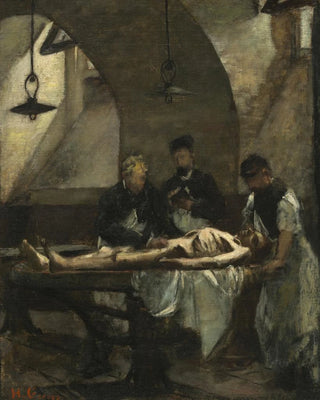Art print | Study for the autopsy at the Hôtel-Dieu - Henri Gervex


View from behind

Frame (optional)
Reproduction Study for the Autopsy at Hôtel-Dieu - Henri Gervex – Captivating Introduction
In the art world, some works stand out for their ability to capture moments of life, death, and emotion. "Study for the autopsy at Hôtel-Dieu" by Henri Gervex is one of those creations that, through its striking realism, immerses us in a scene that is both clinical and profoundly human. This piece, which evokes the mysteries of life and death, invites us to reflect on our own existence while plunging us into the atmosphere of a Parisian hospital of the 19th century. The artist, with undeniable mastery of light and composition, offers us a poignant and unsettling vision, where every detail matters.
Style and uniqueness of the work
Gervex's style is characterized by meticulous attention to detail and a keen sense of color. In "Study for the autopsy at Hôtel-Dieu," he manages to create an atmosphere that is both realistic and dramatic. The characters, frozen in an action that is both mundane and tragic, are rendered with a precision that borders on photographic. Light plays a crucial role, highlighting facial expressions and textures of materials. The choice of colors, often dark and earthy, reinforces the sense of gravity emanating from the scene. Gervex does not merely reproduce reality; he transcends it, transforming it into a reflection on the human condition, on anxiety and acceptance of our mortality.
The artist and his influence
Henri Gervex, born in 1852, was a painter whose career spanned several decades. Influenced by the realist movement and naturalism, he established himself as a major artist of his time. His work is distinguished by a desire to explore themes often considered taboo, such as death and suffering. Gervex was also a key figure in the development of modern art, seeking to depict life as it is, without artifice. His ability to address difficult subjects with remarkable sensitivity has left a lasting impact on his contemporaries and future generations.

Matte finish

View from behind

Frame (optional)
Reproduction Study for the Autopsy at Hôtel-Dieu - Henri Gervex – Captivating Introduction
In the art world, some works stand out for their ability to capture moments of life, death, and emotion. "Study for the autopsy at Hôtel-Dieu" by Henri Gervex is one of those creations that, through its striking realism, immerses us in a scene that is both clinical and profoundly human. This piece, which evokes the mysteries of life and death, invites us to reflect on our own existence while plunging us into the atmosphere of a Parisian hospital of the 19th century. The artist, with undeniable mastery of light and composition, offers us a poignant and unsettling vision, where every detail matters.
Style and uniqueness of the work
Gervex's style is characterized by meticulous attention to detail and a keen sense of color. In "Study for the autopsy at Hôtel-Dieu," he manages to create an atmosphere that is both realistic and dramatic. The characters, frozen in an action that is both mundane and tragic, are rendered with a precision that borders on photographic. Light plays a crucial role, highlighting facial expressions and textures of materials. The choice of colors, often dark and earthy, reinforces the sense of gravity emanating from the scene. Gervex does not merely reproduce reality; he transcends it, transforming it into a reflection on the human condition, on anxiety and acceptance of our mortality.
The artist and his influence
Henri Gervex, born in 1852, was a painter whose career spanned several decades. Influenced by the realist movement and naturalism, he established himself as a major artist of his time. His work is distinguished by a desire to explore themes often considered taboo, such as death and suffering. Gervex was also a key figure in the development of modern art, seeking to depict life as it is, without artifice. His ability to address difficult subjects with remarkable sensitivity has left a lasting impact on his contemporaries and future generations.






